
My frequent trips to Japan, Taiwan, and Korea which began in 1965 introduced me not only to a different culture but expanded my view of war.
World War II murders and casualties overshadowed my childhood.
World War II murders and casualties overshadowed my childhood. They drenched my dreams, sat in the kitchen and followed me to school. Above is a picture of my cousin sent to me in 1938 a few months before she was deported to the German concentration camps where she disappeared … forever.
The German surrender did not end these nightmares. Through the observations of many journalists and novelists, I witnessed the fate of displaced persons who felt lost and forgotten. Most of the 11 million refugees lived in these camps for over three years.
As I grew older, I observed the production of war memorials: the national cemeteries, the town squares with plaques and flags, the narratives of battles that drew attention from the loss of life and the heroism of the combatants, and, of course, the Nazi crimes.
Japan, Korea, and Taiwan had experienced cruel wars as well as Europe. But their memorials were different.
Okinawa’s expansive memorial included the names and of nearly everyone who had died during the catastrophic battle for Okinawa at the end of the war. The list of dead and dying included allies, enemies, and innocents: Japanese, Americans, Koreans, Europeans, and even civilian Okinawans. A visit to this sprawling web of steles felt like being immersed in the war itself. The sense of tragedy for all combatants and innocents was dizzying.
We do not give sufficient credit to the sacrifices of our allies (especially the Russians), or to the loss of civilian lives on both sides. The emphasis is primarily on valor and sacrifice in war.
Taiwan debated about the memorial for the slaughter of 30,000 plus Taiwanese by Chinese troops in 1947. The debate was between those who wanted a pile of bodies and those who favored a design that looked like arms and hands reaching up to heaven in prayer. Prayer and hope for peace defeated self-pity and ammunition for revenge. Approaching this commemorative pillar evokes a sense of reference and even of spiritual healing. I have visited this site many times with my camera and my journalistic pen. Each time I am not filled with rage but with sorrow. If I have any anger at all it is with humanity’s failure to provide lasting peace and happiness.
So, when I visited Hiroshima, the site of the first atomic bomb, I wanted to evoke a sense of energy that was positive and inspiring. The city hall had been the center for the bomb drop. Mysteriously, it was not thoroughly destroyed. It still had a skeletal appearance that provided a promise for a better future.
I affixed my camera to a string and while swinging it through the air, took photographs. The result appeared to show the City Hall burning and then rising again, as if in a resurrection. Its destruction was felt by all—soldiers, civilians, children, women, locals and foreigners. When I look at it, I see it move from the past through destruction, to the hope of a future. It is not a stagnant memorial for or against war. It is a spiritual memory for the future.
From collapse there is renewal, from the fire there is light.


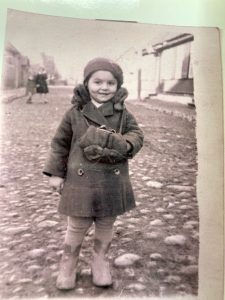
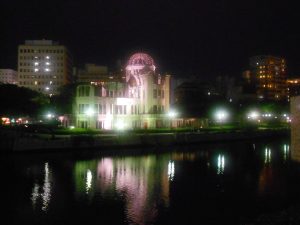
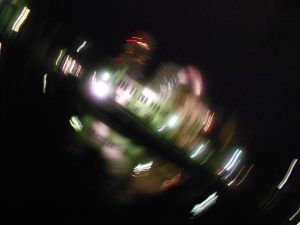
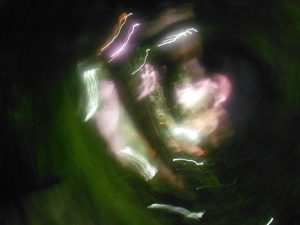
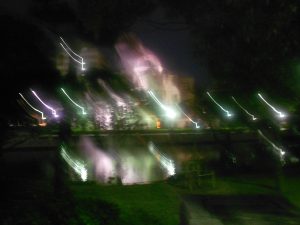
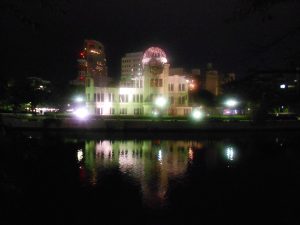

Sorry for you loss(es).
Thanx Richard.
My uncle Bernard was a New York radiologist on a medical team that went to Hiroshima after the war to study the effects of the bombing on the survivors. Always a very articulate guy, never at a loss for words, Bernard refused to talk to his wife and family about what he witnessed..
Dana: The secrecy was compounded by the refusal of our government to allow information about the effects of the bomb. It censored a few films about the bomb’s civilian destruction, and even when the Smithsonian years later wanted to create an exhibition about the issue, Congress at first refused to fund the efforts. Relevant to today, one Congressman objected to the picture of the plane because it showed the nickname “Enola Gay.” He objected, of course, to the “gay.”.
BTW, as an early scholar of this disaster, I did manage to see some of the restricted footage. That is why I am so sensitive to this issue. The survivors of the bomb are still discriminated against due to the unfounded fear that they will spread their radiation disease to others.
Thanks for the thoughtful reflections on the memorials in Asia, the horrendous loss of life and a creative photo manifestation of hope. It is distressing that our memories are so short. When will we ever learn indeed.
I wanted the Hiroshima photos to show that their animation from a still would suggest that the memories and plights of the survivors still exist. We usually only think of the spirits of the dead. But the messages from the tragedy of the living still surrounds us
Thank you for this thought provoking meditation. It begins with the haunting photo of your beautiful cousin whose life was cut short by cruel war gamers. It continues with a discussion that not only addresses those taken away by war but asks us to think about what kind of art, what kind of memorial is appropriate to shape the thinking of those who remain in the aftermath. And it continues with the manipulation of your own camera, attempting to participate in that exercise of making art, and making us think.
thanks for a wonderful summary of my themes